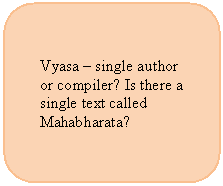Retellings in Other Languages
Mahabharata has been translated into all the Indian languages and also into  English. However, the word translation is perhaps a misnomer for the texts in Indian languages that have made use of the basic Mahabharata story. Firstly, it is difficult to have a translation of a text that has such a fluid nature as this. The basic text is supposed to be the compilation by a few people and not the work of one author Vyasa. In fact, it is said that Vyasa means editor or the one who collated the work of numerous people. Since it passed on through the oral tradition, we can only guess at the numerous accretions or deletions that it went through. The Mahabharata was like a rolling stone which paradoxically gathered moss as it rolled from one generation to another, with the result that it has multiple versions in different parts of India. In some ways this bears out the truth of the statement in the epic: “Poets have told it before, poets are telling it now, other poets shall tell this history on earth in the future” (http://mahabharata-resources.org/quotes.html). English. However, the word translation is perhaps a misnomer for the texts in Indian languages that have made use of the basic Mahabharata story. Firstly, it is difficult to have a translation of a text that has such a fluid nature as this. The basic text is supposed to be the compilation by a few people and not the work of one author Vyasa. In fact, it is said that Vyasa means editor or the one who collated the work of numerous people. Since it passed on through the oral tradition, we can only guess at the numerous accretions or deletions that it went through. The Mahabharata was like a rolling stone which paradoxically gathered moss as it rolled from one generation to another, with the result that it has multiple versions in different parts of India. In some ways this bears out the truth of the statement in the epic: “Poets have told it before, poets are telling it now, other poets shall tell this history on earth in the future” (http://mahabharata-resources.org/quotes.html).
It is difficult to keep track of the multiple Mahabharatas; in fact, most Indian languages have their version of the epic rewritten by a prominent poet of the region. Kabi Sanjay translated it into Bengali for a rural readership (15th century) and Ezhuthachchan wrote the Mahabharatam kilippattu in Malayalam (15th century). Sarala Das in Oriya (15th century), Nannayya, Tikanna and Yerrana in Telugu (11th, 13th, and 14th centuries respectively), Pampa in Kannada (10th century) are a few other examples. Most of them added stories of their own, while doing away with some. Sarala Das edited out the “Bhishma Parva” completely, with the result that his version does not have the Bhagavad Gita. Adharvana’s Telugu Bharatamu (12th century) was a Jain version of the epic. Pampa’s Vikramarjunavijayam was actually a retelling from the Jaina point of view. None of them claimed to have translated the Mahabharata; in fact all of them are considered to be rewritings or retellings from a different perspective. The basic storyline was the same in all the versions, but the perspective from which the story was told was different. Mahabharatam by Ezhuthachchan in Malayalam is presented as a story told by a parrot. It is a framed narrative as the parrot is reciting the story that was told by a suta to a group of sages in the Naimisha forest. This story which was originally recited by Vyasa and taken down by Ganesha, was told to Janamejaya. So the narrative framework makes us aware of the distancing between us and the story in general. Of tribal lore, the Bhil version of the Mahabharata is perhaps the most vibrant. The Bhils are tribals in Central India who have an epic where the women are much stronger than the men; in one story for example, Yudhishtara falls at the feet of Draupadi.
If critical editions can be thought of as interpretations/translations, the most important modern undertaking in this respect must be the BORI’s (Bhandarkar Oriental Research Insitute) publication of a critical edition. A group of scholars, working between 1909 and 1966, compared the manuscripts of various Indian editions and published a comprehensive Critical Edition of the Mahabharata in 19 volumes. As the website of BORI says: “Had institutions had hearts, the Mahabharata would certainly be BORI’s!” The volume when it was eventually published consisted of “18 Parvans; 89000+ verses in the Constituted Text, and an elaborate Critical Apparatus; 19 Volumes: No. of pages: 15000+ demi-quarto size” (http://www.bori.ac.in/mahabharata.htm). Of course this was not a translation in the strict sense of the term, but the elaborate exegesis can certainly be seen as a rewrite.
|